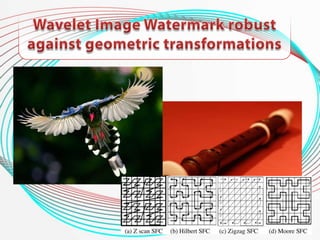Watermark
- 2. Abstract To solve the sensitive problem of signal processing and geometric distortion of digital image watermarking, an image watermarking algorithm against geometric attacks was proposed in the paper. After decomposing the whole image with 3 level of discrete wavelet transform and transforming the watermark image by Arnold shuffling, embed the watermark data to the media frequency coefficients of wavelet domain according to the conceal quality of Human Visual System (HVS); and extract two invariant centroids as factors to correcting geometric transformation by using the theories of invariant centroid, the watermarked image could be corrected. The experimental results show that the algorithm is robust to general signal processing and geometric attack such as rotation, scaling and translation.
- 3. Secure Part In Secure Part In Secure Part Result Embedding Attacking Detecting Signals Function E Function A Retrieval Function S General digital watermark life-cycle phases with embedding-, attacking-, and detection and retrieval functions
- 4. âĒ The transformation for a square digital image is
- 6. (1) Use Haar wavelet, the images A be done 3 level discrete wavelet transform, to produce LL3, HL3, LH3, HH3 and so on ten sub-band. (2) Use ascending order for the intermediate region HL3, LH3 of image, get the sequence C, and note the location corresponding to order (3) Arnold scrambling the watermark information, then obtain scrambling watermark information W. (4) Using the multiplicative rule, large absolute value coefficient with C embed , then get the watermark information W. câē i = ci(1 + alpha*wi) where the size of determines the intensity of the image frequency modified by the watermark signal.
- 7. (5) According to corresponding sequence in step (2), the modified media frequency sequence câē i is assigned to corresponding location of original intermediate frequency regions HL3, LH3. (6) Use the modified wavelet coefficients in step (5) by discrete inverse wavelet transform to get image embedded with the watermark information. (7) Extract the two invariant centroid points tm, tn of the images embedded watermark information, and obtain the coordinates and corresponding radius r1, r2 of the two points as geometric distortion correction key for watermark detection.
- 8. (1) Use the methods described before as well as the key of geometric distortion of the watermark image rotation, scaling, translation correction. (2) Use DWT for watermarking image Aâ with geometric distortion correction to get LL3, HL3, LH3, HH3 and so on ten sub-bands. (3) According to the corresponding position sequence and the embedded watermark sequence size, a embedding position of intermediate frequency regions HL3, LH3 in watermark image is determined, and embedded watermark sequence câē i is obtained. (4) Use the Eq. (4), to get scrambling watermark information Wâē. Wâē i = (câē /ci â 1)/alpha (5) Use the saved Arnold scrambling key to do periodic transformation for Wâē, then get the extracted watermark image Wâ.
- 9. âĒ Extraction of the Invariant Centroid âĒ Parameter Correction of Geometric Distortion âĒ Image Rotation Correction Algorithm âĒ Image Scaling Correction Algorithm âĒ Image Translation Correction Algorithm
- 10. Wavelet Host Image LL3,LH3,HL3 transform Another strategy use only high value Use LL3 but coefficients to hide your coefficients low energy or LH3 and/or HL3 for higher energy Another strategy use additive way or multiplicative way
- 11. Wavelet Wavelet Wavelet Host Image transform transform transform Watermark Image LL3,LH3,HL3 Use LL3 but Arnold low energy scrambling Watermarked Wavelet +* Image inverse 3 levels
- 16. Wavelet Wavelet Wavelet Host Image transform transform transform Watermark Image LL3,LH3,HL3 Use HL3 Arnold scrambling Watermarked Wavelet +* Image inverse 3 levels
- 18. ans = Correlation between watermark and recovered watermark 0.1215
- 19. Wavelet Wavelet Wavelet Host Image transform transform transform Watermark Image LL3,LH3,HL3 Use HL3 Secret Key RC4 Encryption Watermarked Wavelet +* Image inverse 3 levels
- 20. Wavelet Wavelet Wavelet Host Image transform transform transform Watermark Image LL3,LH3,HL3 Use HL3 Permutation Watermarked Wavelet +* Image inverse 3 levels
- 21. Wavelet Wavelet Wavelet Host Image transform transform transform Watermark Image LL3,LH3,HL3 Use HL3 Secret key XOR Watermarked Wavelet +* Image inverse 3 levels
- 22. Wavelet Wavelet Wavelet Wavelet Host Image transform transform transform transform Watermark Image LL4,LH4,HL4 Use HL4 or LH4 or LL Secret key XOR Watermarked Wavelet +* Image inverse 3 levels
- 23. Wavelet Wavelet Wavelet Host Image transform transform transform Pseudo random LL3,LH3,HL3 generator or Use HL3 LFSR Watermarked Wavelet +* Image inverse 3 levels
- 24. Wavelet Wavelet Wavelet Host Image transform transform transform Host Watermark Watermarked LL3,LH3,HL3 Watermark Use HL3 Arnold Watermark #2 Scrambling Watermarked Wavelet +* Image inverse 3 levels
























